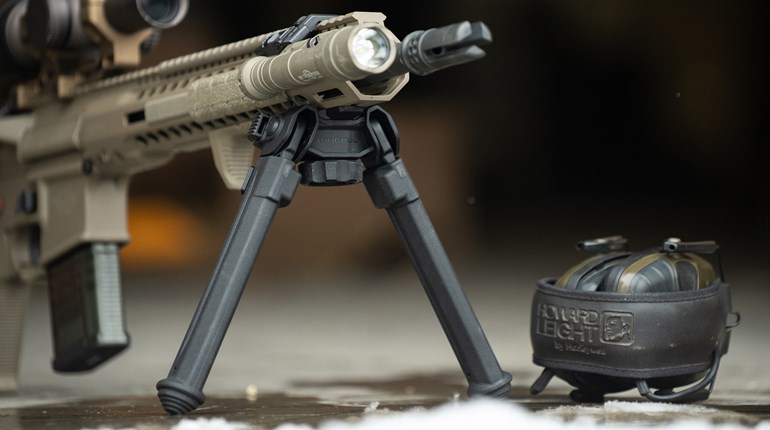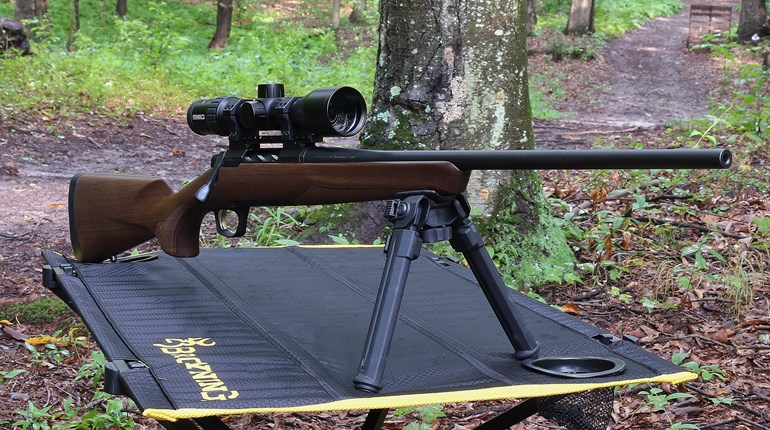
The first bipod I ever laid hands on was one of those cheap, plastic (no one said “polymer” in those days) scissor-jobs that used the clamping force of its own legs to hug the barrel. I was in high school at the time and had traded for an unfortunate M1 Carbine that the previous owner had tried to convert into a sniper rifle. I did not much care for the bipod or the finicky rifle and quickly traded them both away.
My introduction to the pros, cons and proper use of functional bipods came many years later during my introductory sniper training. My first was a Harris bipod—the BL model to be exact—that had 9- to 13-inch legs, did not tilt (swivel) and used awkward friction knobs to adjust leg length. I am sure it was great for bench shooters and concrete pads, but it truly sucked for sniping. We all gravitated to the most practical of Harris bipods—the BRMS. This version has 6- to 9-inch legs with notches that adjust quickly and tilts to an acceptable degree on uneven terrain. The BRMS has never been perfect, but it has still managed to achieve a balance between strength, features and weight better than any other contemporary bipod could. That’s why Harris bipods are still on so many rifles today.
Several companies have bested the Harris in one way or another over the years. Early attempts to create lighter bipods could not stand up to the abuse doled out in the real world. Others made very stout bipods that had different advantages over the Harris models. Accu-Shot’s BT-10 (a.k.a. Atlas) is rock-solid and offers multiple locking-leg angles, tilt and traverse functions and has a quick length-adjust system.
Grip Pod Systems’ GPS family of bipods combines the functionality of a vertical foregrip with the utility of on-demand, spring-loaded bipod legs. Other models lower a rifle’s center of gravity—thus helping to create a more stable firing platform—with units that mount higher on the rifle’s fore-end. Each of these attempts to make a better bipod has succeeded in some form, but they all have limitations, too. They either tread the line between huge and obnoxious, add a tangible amount of weight, are slow to deploy and/or fold or lack the flexibility to work well in actual field conditions. But, things are changing in the bipod world. For the first time in 25 years I no longer default solely to “Harris BRMS 6- to 9-inch” when someone asks for bipod advice.
Innovative newcomers use better materials, designs and/or attachment systems to drop weight while still maintaining the strength needed to survive harsh use in harsher environments. The new Magpul Bipod uses a combination of aluminum and its familiar injection-molded polymer to shave a couple ounces off the baseline Harris BRMS. But, the 11-ounce Magpul Bipod also has advanced features, including the ability to both tilt from side to side and traverse (pan) with friction controlled by a knurled, finger-adjustable knob. Leg notches are positive and—while lacking the Harris design’s springs to assist opening quickly—it is still fast to deploy and fold. Best of all, Magpul offers versions that mount directly to M-Lok slots, as well as Picatinny rails and A.R.M.S. mounts. Like the Harris, Magpul’s Bipod only folds in one direction, but it is simple and durable.
UTG’s Recon Flex is a newer bipod that will appeal to shooters on a budget or those needing to keep things trim. At 10.8 ounces, the UTG model is actually made up of two separate legs that mount directly to a rifle fore-end’s M-Lok or KeyMod slots. The Recon Flex is available in two leg lengths and the legs fold independent of each other, locking forward, backward or in any one of three down positions. The legs are equipped with positive notches but can also be locked to any length by way of friction knobs. My only complaint about the UTG bipod is that it does not appear to be made in the USA. That is a big strike for me personally and I know that many of my friends will not consider them for that reason. So far, the UTG bipod I have been using for several months has held up to all the abuse I can give it, short of hurting myself in the process.
Carbon Fiber units are available for those situations where every shaved ounce equals a higher chance of success (or survival). Unfortunately, you will pay dearly for each ounce shed by a CF bipod. Magpul’s Bipod and the Harris BRMS are both in the $100 range while the UTG models are roughly half that price. The 5.6-ounce Spartan 300 from Spartan Precision Equipment is light and simple enough to be slipped in a coat pocket and snapped in place once needed. But, this carbon fiber bipod is priced in the truly painful realm at $475. I have not used the Spartan 300, so I cannot comment on its performance, but it strikes me as exactly the type of thing I was looking for back in the days when I carried a ridiculous amount of gear in the most hideous terrain I have ever encountered.
Those are just a few new options. Others cater to the minimalist hunting market or other specialty needs. I still recommend the Harris BRMS as an option when asked for a solid, light and proven bipod recommendation. But, that suggestion is now accompanied by other options and to my way of thinking, more choices equals a better chance to get just the right fit for your rifle’s bipod needs.






































